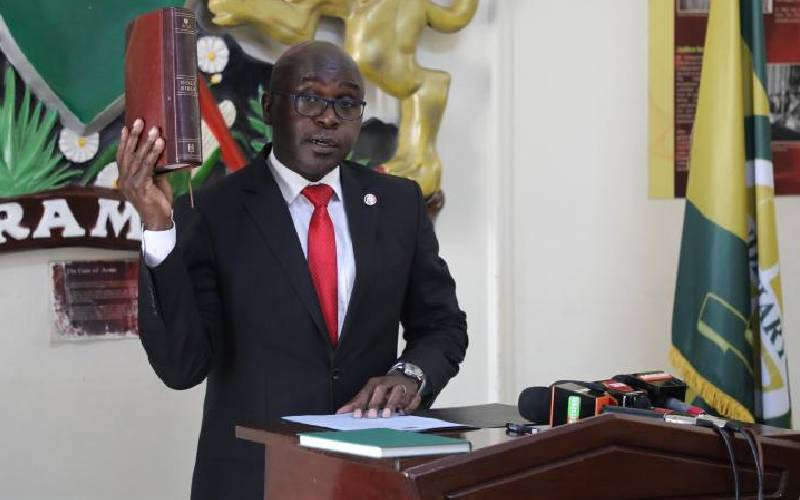By LUKE ANAMI
The stage is set for a battle in Parliament over the proposed formula to be used by the State to allocate revenues to counties.
MPs in populous counties like Nairobi, Kiambu, Bungoma, Nakuru and Kakamega are spoiling for a fight when the matter comes up before the House. The five counties were the biggest losers after the Commission on Revenue Allocation (CRA) reviewed its template for sharing the national cake between the counties. CRA reduced the size of the population segment of the formula thereby cutting Sh3.9 billion in total from the five counties’ budgets. This is based on the 2011-2012 Budget used by CRA for purposes of crafting the formula.
With a reduction of as much as Sh1.6 billion, Nairobi County, with a population of 3.1 million, lost the most following the review of the Commission of Revenue Allocation’s formula.
Marginalised counties like Turkana County gained the most after poverty index segment of the formula was raised as a measure for division of the revenue, translating to Sh40 billion.
Turkana, with a population of 855,399, would get Sh2.4 billion more than its initial allocation in April. Mandera, with an increment of Sh1.2 billion, is the second biggest beneficiary should the new formula be implemented.
Biggest loser
Kilifi and Garissa had their allocations increased by Sh300 million and Sh400 million respectively.
After Nairobi, Kiambu County was the other biggest loser with its previous allocation reduced by Sh700 million. Nakuru and Bungoma Counties each lost Sh600 million.
These are the consequences of the review of the CRA that now recommends that the poverty index segment of the template account for 20 per cent of allocations, up from 12 per cent of the Sh203 billion, which would be shared out among the 47 county governments for the 2012/2013 financial year.
Predictably, the revised formula has kicked up a storm even before it is discussed in Parliament. Leaders from regions that had their share reduced have opposed it while those who are tipped to have a larger share have welcomed it.
“You cannot allocate revenue on the basis of poverty index and land mass. The ultimate factor that should be used to determine how much revenue would be allocated is population. The more the people the more the services they require and, therefore, the more resources they should get,” Housing Minister Soita Shitanda charged.
“We should not rely on the poverty index because everyone in Kenya is poor anyway,” added the Malava MP.
“And if you allocate revenue based on land size then you are missing the point. We are opposed to the new formula and we are going to put up a fight on the floor of the house.”
Garsen MP Danston Mugatana however said he is happy with the formula, as it has taken into account the interests of the marginalized, which he added had been ignored earlier.
Stay informed. Subscribe to our newsletter
At Sh10.1 billion, Nairobi County, however, still gets the lion’s share of the total revenue allocation.
The higher influence of the poverty index in the division of the funds has thrust Turkana County as the region with the second highest allocation (Sh8.2 billion). Others are Mandera (Sh6.9 billion), Kakamega (Sh6.9 billion), Bungoma (Sh6.6 billion) and Nakuru (Sh6.3 billion).
Initially, Nairobi, with a population of 3.1 million, had been allocated Sh11.7 billion. With a population of 1.6 million Kakamega had been allocated Sh7.3 billion.
Bungoma could have been allocated Sh7.2 billion based on previous calculations while Kiambu and Nakuru had Sh6.5 billion and Sh6.9 billion respectively.
The initial formula would have seen the five highly populated counties consume at least 20 per cent of the total allocations.
Little allocations
Initially, counties with fewer populations had little allocations like Lamu (Sh1.4 billion), Isiolo (Sh1.9 billion), Samburu (Sh2.2 billion), Taita Taveta (Sh2.34 billion) and Tharaka Nithi (Sh2.35 billion) get the lowest.
But in the revised formula Lamu, with a population of 101,539, is set to receive Sh1.6 billion and Isiolo, with a population of 143,294, Sh2.3 billion.
Tharaka Nithi (365,330 people) would get Sh2.4 billion while Elgeyo Marakwet (369,998) has Sh2.5 billion. And Taita-Taveta with a population of 284,657 closes the last five with an allocation of Sh2.58 billion
Maragwa MP Elias Mbau, who also chairs Parliament’s Budget Committee, says the earlier formula by CRA was a working document and Parliament will discuss the new proposals in two weeks time.
“The CRA formula is being executed on the principle and philosophy of redistribution. There are regions which feel they have been marginalised for long. The CRA formula was meant to elicit debate and public participation which it has done,” Mbau said.
“Originally those from marginalised regions were opposed to the earlier formula. But the most populous counties were somehow satisfied with the earlier proposals. Because the formula is going to last for the next three years as envisaged in the Constitution, let us embrace it now,” Mbau added.
CRA chairman Micah Cheserem attributed the changes to views from the public.
Five parameters
“Remember we visited all 47 counties. Following views from the public and discussions with the Parliamentary (Budget) Committee, we settled on the average of 45 per cent on population. In our meetings, some people wanted it higher while others wanted it low (the percentages of 5 parameters) but we have now opted to the new one and the committee has agreed with us,” Cheserem explained.
The county revenue allocation is based on five parameters for sharing the revenue recommended by CRA.
Some 25 per cent of the revenue translating to Sh50.75 billion would be shared equally.
The new CRA revised figures are contained in a report tabled in Parliament on Wednesday by Finance Minister Njeru Githae.
There would be an equal share that would comprise 25 per cent of the allocation. This has been reviewed upwards from 20 per cent.
 The Standard Group Plc is a
multi-media organization with investments in media platforms spanning newspaper
print operations, television, radio broadcasting, digital and online services. The
Standard Group is recognized as a leading multi-media house in Kenya with a key
influence in matters of national and international interest.
The Standard Group Plc is a
multi-media organization with investments in media platforms spanning newspaper
print operations, television, radio broadcasting, digital and online services. The
Standard Group is recognized as a leading multi-media house in Kenya with a key
influence in matters of national and international interest.
 The Standard Group Plc is a
multi-media organization with investments in media platforms spanning newspaper
print operations, television, radio broadcasting, digital and online services. The
Standard Group is recognized as a leading multi-media house in Kenya with a key
influence in matters of national and international interest.
The Standard Group Plc is a
multi-media organization with investments in media platforms spanning newspaper
print operations, television, radio broadcasting, digital and online services. The
Standard Group is recognized as a leading multi-media house in Kenya with a key
influence in matters of national and international interest.








